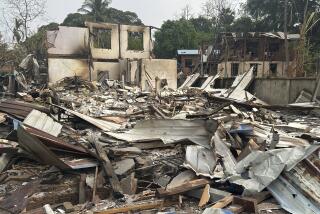The Buddhism bomb
- Share via
The passive, otherworldly image of Buddhism can be misleading. In Burma, where two-thirds of the country is Buddhist, the religion has an overwhelming influence on day-to-day life and plays a continuing political role that makes the current protest marches by tens of thousands of monks through the streets of Yangon especially significant.
Buddhism has long been one of the key ingredients of Burmese nationalism, and it has been used by political leaders of all stripes as a source of legitimacy. To be in the top leadership of the military or the government requires public acceptance of the Buddhist faith. Indeed, the two most volatile elements in Burmese society, from the government’s perspective, are the monks and students because they are respected moral forces. If the government represses them, it does so at its peril.
The military junta that runs Burma, known as Myanmar under the regime, is well aware of this, and it has been measured in its response to the protests, so far. The demonstrations began Aug. 19 after the government raised fuel prices, and on Sunday, the largest protests yet were held. About 10,000 monks marched through the streets of Yangon (and other cities across the country), shouting their solidarity with jailed democracy leader Aung San Suu Kyi and waving banners (including one that read “Love and kindness must win over everything”).
There have been few public protests by monks in the last decade and a half. But before that, their protests against various governments go back to colonial times. When the British conquered Burma in the Third Anglo-Burmese War (1885-86), they eliminated the role of the leader of the Buddhist clergy, the Supreme Patriarch, thus destroying the organizational cohesiveness of the faith.
But they couldn’t ban the religion itself, and even without an organized leadership, Buddhism remained a powerful force. The inroads of Christianity in administration and education -- a result of the British influence -- caused a Buddhist backlash, and monks became martyrs, dying in British jails for the cause of independence and Buddhism.
Buddhism has been used politically in the civilian and military administrations ever since. Civilian Prime Minister U Nu, a devout Buddhist, used Buddhism to win the 1960 elections by promising to make it the state religion. Every king and every leader (including those in the military) has built pagodas as symbols of faith. U Nu built the Peace Pagoda in the early 1950s; Gen. Ne Win built one in the years that followed, as has every military leader since. Such acts not only indicate personal devotion but add legitimacy for the government.
Devout images of the leadership are ubiquitous. Virtually every day in the official newspaper, a senior military official is depicted making some act of homage to the monks and showing respect for the religion. The military has assiduously attempted to demonstrate its unwavering support of Buddhism. There is certainly some element of belief in all this, but also perhaps a concern about the potential ability of the religious leadership to help stir up dissent.
Since 1988, the Buddhist hierarchy has been strictly controlled by the government, and what is taught in Buddhist schools has been carefully regulated. But such control does not reach down to the individual monasteries or younger monks, many of whom have been demonstrating in the last few days.
The junta recognizes the potential of the monks to inflame popular opinion against the regime. In 1990, the uniformed army brutally suppressed a protest by hundreds of monks in Mandalay, arresting and defrocking some and shutting down monasteries, but the reaction to the most recent events has been notably different. The government has not (at least not yet) directly used military personnel in uniform to suppress the demonstrators, although there are charges it may have used soldiers in mufti and civilian members of the Union Solidarity and Development Assn. (the military’s mass mobilization organization) to do so.
The junta could easily suppress these demonstrations by force -- but in doing so it could terribly damage the image of the military, both within Burma and internationally. The government is perfectly aware that the demonstrations, while important, are unlikely to topple the military regime -- unless the government reacts in the wrong way.
The fact is that there will eventually be change in Burma, but when it comes, it likely will emerge from elements within the military worried that the image of the institution will be irrevocably damaged. Years of political and economic frustration have spawned a situation in which even a small event could spark that powder keg.
More to Read
Sign up for Essential California
The most important California stories and recommendations in your inbox every morning.
You may occasionally receive promotional content from the Los Angeles Times.













